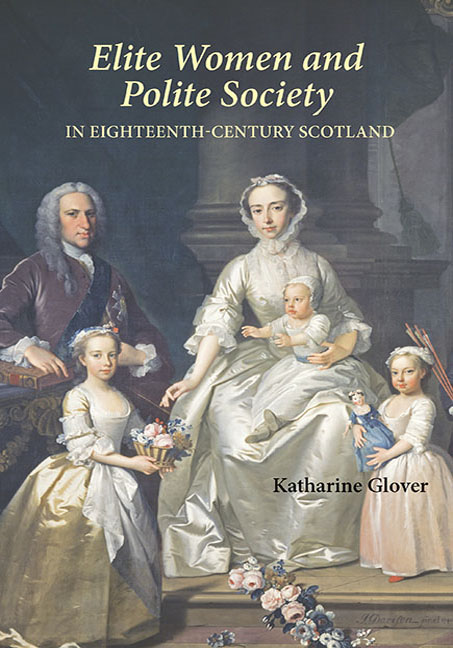Book contents
- Frontmatter
- Contenst
- Dedication
- Acknowledgements
- List of Abbreviations
- Preface
- 1 Elite Women and Eighteenth-Century Scottish Society
- 2 Education and Upbringing
- 3 Reading and Print Culture
- 4 Polite Sociability: Space and Social Practices
- 5 Politics and Influence
- 6 Travel, Tourism and Place
- Conclusion
- Appendix Biographical Backgrounds
- Bibliography
- Index
- Frontmatter
- Contenst
- Dedication
- Acknowledgements
- List of Abbreviations
- Preface
- 1 Elite Women and Eighteenth-Century Scottish Society
- 2 Education and Upbringing
- 3 Reading and Print Culture
- 4 Polite Sociability: Space and Social Practices
- 5 Politics and Influence
- 6 Travel, Tourism and Place
- Conclusion
- Appendix Biographical Backgrounds
- Bibliography
- Index
Summary
In July 1746, Betty Fletcher, the fourteen-year-old daughter of a prominent Edinburgh judge, wrote a letter to her brother in which she described the supposedly quiet social life of Edinburgh during the summer social season:
the town is very empty at present Colonel Leese regiment keeps it alive it helps assemblys & plays thers two plays every week & the last assembly is to be on thursday Lady Ancrim [sic] has a drawing room every Wednesday so the twon [sic] is tolerable gay tho few company in it … the Meadow is vastly frequented in fine weather
Despite describing the town as ‘very empty’, suggesting a lack of ‘good’ company, she acknowledged the entertainment provided by two plays a week and a dancing assembly, as well as a private gathering organised in an aristocratic townhouse. She noted that, in good weather, the gentry and nobility would escape the cramped and smoky confines of their Old Town apartments to ‘take an airing’ in the Meadows, the open ground lying just to the south of Edinburgh's urban boundaries. These social gatherings afforded men and women the opportunity to meet and gossip with friends and acquaintances, to show off their good taste in dress, manners and deportment, and to observe that of their counterparts. In assemblies, plays, outdoor promenades and a ready supply of men in military uniform, Betty Fletcher was outlining the essential ingredients necessary to maintain a lively social atmosphere for young women like herself and her sisters. This book, however, will demonstrate that the social activities which she was describing held a meaning far beyond the entertainment of teenage girls.
Pleasurable as they may have been, these activities were not merely frivolous pastimes. Rather, they created new opportunities for elite Scotswomen to engage with the world beyond their immediate social circles, which had far-reaching repercussions for both individuals and for Scottish society more broadly. Whilst their foremothers’ lives were not, of course, bereft of sociability or enjoyment, and whilst girls like Betty Fletcher were still expected to grow up to take on important practical roles in estate and household management, the ideological prominence given to women's participation in social, often public activities such as those outlined above belonged to a culture that was self-consciously progressive and new to the eighteenth century.
- Type
- Chapter
- Information
- Publisher: Boydell & BrewerPrint publication year: 2011

